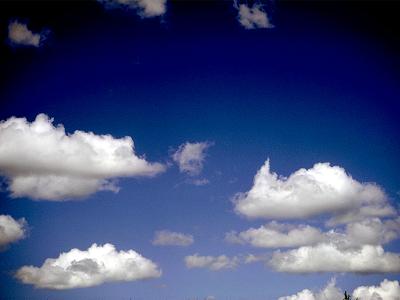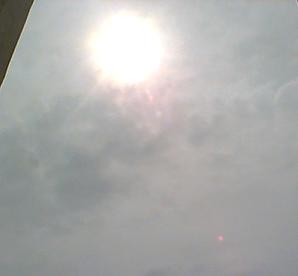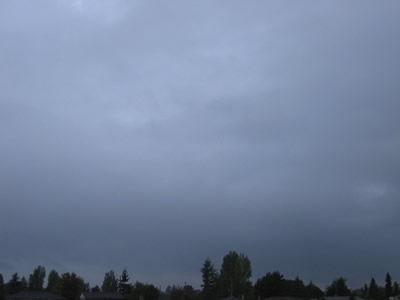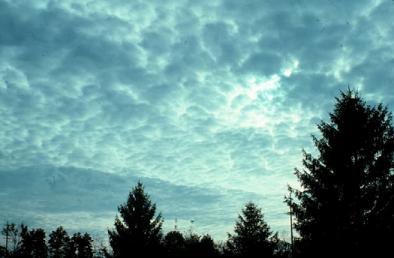There are many ways to find out how the weather will be where you are. You could make a fire and see if the smoke gets pushed to the ground, look at the clouds, or look at your local weather channel.
This article will be about how to decide what the weather will be by looking at the clouds. This skill could come in handy if you are camping, going on a boat, planning a picnic, or if your stranded some where.
This information will come from, "SAS Survival Handbook" by John Wisemen.
Clouds are the most reliable of the weather signs. Clouds are mostly made up of masses of water vapor which becomes visible as it condenses with cooling. If this cooling continues, the droplets of water increase in size until, to heavy to remain airborne, they fall as rain.
Sometimes when the temperature rises sufficiently a cloud will evaporate and disappear.
There are ten main types of clouds which differences come from their different altitudes. The higher the clouds altitude, the better the weather.
The names of the clouds types are of the following: Cirrocumulus clouds, Altocumulus clouds, Cumulonimbus clouds, Cumulus clouds, Cirrus clouds, Cirrostratus clouds, Altostratus clouds, Nimbostratus clouds, Stratocumulus clouds, and Stratus clouds.
Cirrocumulus clouds: Are small rounded masses, looking like rippled sand and often referred to as a 'mackerel sky'. Normally an omen of fair weather, they usually follow a storm and dissipate, leaving a blue, clear, and brilliant sky.
Cirrocumulus clouds

Altocumulus clouds: Are fair weather clouds, similar to cirrocumulus but on a larger scale, thicker, not so white, and with shadows in them. They also usually appear after a storm has passed.
Altocumulus clouds

Cumulonimbus clouds: Are low thunder clouds. Dark and angry looking, they may tower to 20,000 feet with the top flattening out, which is called a anvil top. This type of cloud can brings hail, strong winds, and thunder and lightning.
Cumulonimbus clouds with rainbow

Cumulus clouds: Are very easy to recognize: fluffy white clouds, not unlike cauliflowers. They are usually and indication of fair weather when spread apart widely, if they become larger and may develop many heads, they are capable of producing heavy showers. Cumulus clouds at sea in a otherwise cloudless sky are often an indication of land beneath them.
Cumulus clouds

Cirrus clouds: Are high, wispy clouds formed by ice crystals which give them a white appearance. These types of clouds are often seen is fair weather.
Cirrus clouds

Cirrostratus clouds: Are clouds made up of ice particles and look like white veins. These are the only clouds that produce a halo around the sun or moon. If the halo gets larger, it is an indication of fair weather. If the halo gets smaller, it is an indication of rain.
Cirrostratus clouds with halo around the sun

Altostratus clouds: Form a grayish veil in which the sun or moon may appear as a watery disk. If wet weather is approaching the disk will disappear and the cloud will thicken and darken until it begins to rain.
Altostratus clouds

Nimbostratus clouds: From low, dark blankets of cloud and spread gloom, they mean snow or rain within four to five hours and usually the rain continues for hours.
Nimbostratus clouds

Stratocumulus clouds: Form low, lumpy, rolling masses, usually covering the whole sky, though often thin enough for the sun to filter through them. Light showers may precipitate from these clouds but often dissipate in the afternoon and leave a clear night sky.
Stratocumulus clouds

Stratus clouds: Are the lowest of the clouds and form a uniform layer like fog in the air - they are often described as hill fog when they occur. They are not a normal rain cloud but can produce a drizzle. When they form thickly overnight and cover the morning sky, they will usually be followed by a clear day.
Those are the different types of clouds and the definitions of what kind of weather they may produce.
My favorite type of cloud is the one that produces a halo around the moon or sun. I have only witnessed this halo once around the moon. It was HUGE! The halo was spectacular.
Another little way to know if good weather or bad weather is coming is the old saying, "Red sky at night, Shepherd's delight, Red sky in the morning, Shepherd's warning."
Which means if there is red sky at night, there will be fair weather. If there is red sky in the morning, this means rain could and most possibly be coming.
This is Rex13 signing off.
Author's Note: Sources: SAS Survival Handbook by John "Lofty" Wisemen
Editor's Note: Rex13 did include a picture of Stratus clouds but unfortunately, due to the Times' 9 picture limit, I could not include it.